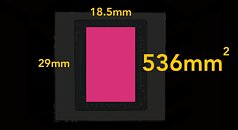Monday, October 5th 2020

AMD "Big Navi" GPU Die Pictured? Allegedly Measures 536mm²
Coreteks, in a video presentation on Sunday, released what is possibly the very first picture of the AMD "Big Navi" GPU silicon, which could power the company's next-generation Radeon RX 6000 series flagship graphics card. The grainy, blurry-cam picture reveals a mostly square package with a large, rectangular die at its center, which Coreteks estimates to be 536 mm² in die-area, with 29 mm x 18.5 mm (LxW) dimensions. The channel used an unusual method for measuring the die size. The chip is rumored to feature around 80 compute units based on the RDNA2 graphics architecture, which includes fixed-function hardware for real-time raytracing, as RDNA2 is designed to meet DirectX 12 Ultimate logo requirements. We'll know more about the chip in the run up to its October 28 unveiling.
Source:
Coreteks (YouTube)


37 Comments on AMD "Big Navi" GPU Die Pictured? Allegedly Measures 536mm²
if is 7nm+ (+?) than even higher count...
The video link
Also this no reasons...just felt it needed to be inserted into the matter. I wonder if anyone's ever been crazy enough to get that as a tattoo.
Could it be that the coming multi module GPUs will have a separate chip let for the RT cores.
Anyway, now that I think about it, what were those pictures hiding on the back of the chip ? Well, now we know there were many capacitors there :). Does that mean people knew something was problematic with those from all the way back then ? Food for thought.
Just like when AMD changed the BIOS (clocks speeds etc,) for the rx 5000 series few days before release or something like that. How can anyone know that?
I guess hiding the back of the chip was meant to prevent people from estamating the die size... And Coreteks saw those pics, counted 1+1=5 and came up with his nonsense theory...
The Big navi is the one really. A tank, large chunks of cache, 80+ CU's, just a overall well optimized arch that will beat the shit out of Nvidia in both power and performance.
Team ATI has bin sleeping for a while, now the bear is woken up.